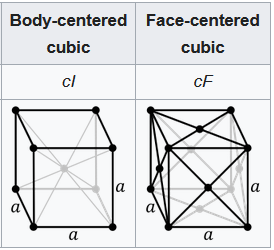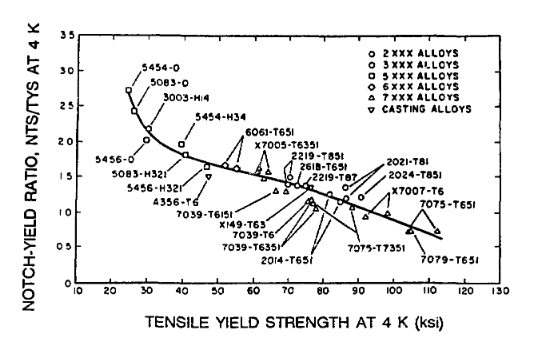It’s important to understand the ductile-to-brittle transition temperatures (DBTT) of metals when considering which materials to use for applications functioning under cryogenic environments. Some more ductile metals at room temperature may become brittle materials at low temperatures. As a result, they develop fractures, and the structure may fail. For example, the DBTT of the low-carbon steel used in the building of the Titanic may have contributed to the ship’s sinking in an environment that was just -4 °F.
However, is aluminum ductile or brittle? Is DBTT applicable to all metals, including 6061 aluminum? Below, we dive deeper into DBTT and why 6061 aluminum does not have a ductile-to-brittle transition temperature.
Understanding the Ductile-to-Brittle Transition Temperature
DBTT refers to the temperature of the material at which it enters into the brittle phase from the ductile phase. At this point, the material can no longer sustain the loading force without developing a fracture.
Pure metals tend to have a definite transition temperature, while in alloys, this transition room temperature is uniquely defined and may occur over a finite range.
In this regard, the Charpy Impact Test, also known as the Charpy V-notch test, is conducted to determine the toughness of a material. Surprisingly, pure aluminum does not have a DBTT.
Ductile-to-Brittle Transition Temperature of 6061 Aluminum
Aluminum has a face-centered cubic (FCC) structure. Face-centered cubic materials do not have any ductile-to-brittle transition; they always tend to remain ductile metals.
Why? For that, we need to understand the slip system of the material. Metals deform along the most closely packed directions on the most closely packed slip planes, also known as slip systems. The dislocation of a slip happens when a corner atom jumps to the center of the cube.
Let’s take a look at the unit cell of BCC and FCC materials, as shown below.
 FCC vs. BCC lattice structure
FCC vs. BCC lattice structure
Both structures have the same number of slip systems (12). However, unlike BCC, FCC has closely packed planes belonging to each slip system.
At elevated temperatures, both FCC and BCC structures have mobile dislocations, meaning they can go through plastic deformation without undergoing fracture. However, at a low melting point, you need a certain amount of thermal energy to activate dislocations in BCC structures, but dislocations happen in FCC independent of the surrounding temperature. As a result, FCC stays as a ductile metal even at low temperatures and displays no DBTT phenomenon.
This is why you can’t find any data regarding the ductile to brittle transition temperature of 6061 aluminum.
|
Top-Grade Aluminum for Every Purpose and Industry |
||
|
New Aluminum Plate 6061 |
New Aluminum Rectangular Bar |
All Aluminum Shapes |

|

|

|
|
Customizable thickness: Measure in inches. You can get various options for all industry applications.
Can be cut to specific shapes and sizes: Excellent weldability to cater to unique project needs. Corrosion resistance: Grades like 6061-T651 are perfect for marine hardware applications that require superior rust resistance. |
Environmental resilience: Due to its heat treatable nature, 6061 aluminum does well in extreme conditions.
Wide selection of sizes and dimensions: Choose your sizes based on tensile strength, width, and weight. Good machinability: It’s lightweight and high strength makes it flexible for a number of applications. |
Reliable supply: Consistent, certified aluminum stock you can trust.
High-quality material: Superior-grade aluminum for precision needs. Custom cuts: Accurate cuts down to thousandths of an inch. |
Unique Low-temperature Aluminum Applications
Aluminum is one of the highly ductile metals or ductile materials while being tough at low temperatures, thanks to the FCC structure of the metal. Such physical properties are an essential advantage for offshore installations in the northern hemisphere, which easily reaches -40°F. This makes ductile metals and ductile materials such as aluminum quite useful.
5000 and 6000 series aluminum alloys are considered the most suitable for cryogenic applications due to their high notch-yield ratio, which is a ratio between notch-tensile strength and tensile-yield strength for a quality control test of material against fracture testing. Additionally, these aluminum alloys offer excellent corrosion resistance and can benefit from any heat treatment to enhance their properties further.
However, it’s important to note that not all pure aluminum alloys behave the same under low temperatures. For instance, the strength of 6061 increases as the temperature is reduced, whereas that of 5456 aluminum remains almost constant.
The graph below shows the tensile yield strength at 4K (ksi) force for different aluminum alloys.

Some industries use low-temperature fluids to achieve desired working conditions. In this regard, aluminum equipment and installations can offer exceptional strength and high ductility, even at -320.8 °F.
The table below lists grades of different aluminum alloys used over a wide range of cryogenic temperatures.
| Temperature | Suitable Aluminum Alloys |
| -45 °C | Almost all except 7075-T6 and 7178-T6 |
| -100 °C | 7079-T6 |
| -196 °C | 2024-T6, 7039-T6, 5456-H343 |
| -253 °C | 2024-T4, 6061-T6, 2219-T87, 5052-H38, 5083-H38 |
While the absence of a ductile-to-brittle transition temperature of 6061 aluminum benefits industries working with cryogenic applications, its soft nature is challenging for machine operators. The low melting point of the aluminum alloy can result in gummy build-up around the tool edge.
Purchase High-Quality Aluminum From a Reputable Supplier
Industrial Metal Services has been supplying various aluminum alloys to the San Francisco Bay Area and beyond for more than two decades. We can provide 6061 aluminum plates, bars, rounds, and other aluminum alloys, including MIC-6, ALCA-5, ATP-5, and K100-S. Our inventory also stocks other metals, such as iron, copper, steel, and titanium, with new, mill-sourced materials and verified remnants available for purchase. To save you from machining challenging metals like aluminum, we also have a state-of-the-art metal sawing infrastructure that can cut even 12-inch-thick aluminum plates with ease.
 Angle
Angle Cast Plate
Cast Plate Diamond Plate
Diamond Plate Flat Bar
Flat Bar Plate
Plate Round Bar
Round Bar Square Bar
Square Bar Square Tubing
Square Tubing Round Tubing
Round Tubing Angle
Angle Channel
Channel Diamond Plate
Diamond Plate I Beam
I Beam Round Bar
Round Bar Sheet
Sheet Square tubing
Square tubing Round Tubing
Round Tubing Rectangular Tubing
Rectangular Tubing Plate
Plate Rectangular Bar
Rectangular Bar Rectangular Tubing
Rectangular Tubing Round Bar
Round Bar Sheet
Sheet Square Bar
Square Bar Square Tubing
Square Tubing
